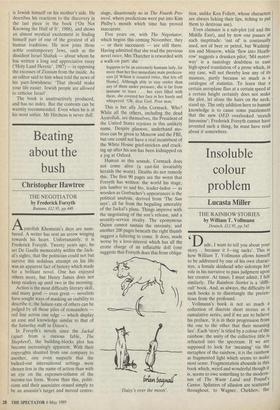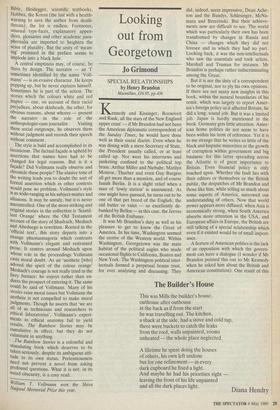Insoluble colour problem
Lucasta Miller
THE RAINBOW STORIES by William T. Vol[mann
Deutsch, £12.95, pp.541
ude, I want to tell you about your story... because it f---ing sucks'. This is how William T. Vollmann allows himself to be addressed by one of his own charac- ters, a female skinhead who sidesteps her role in his narrative to pass judgment upon her creator. At times, I must admit, I felt similarly. The Rainbow Stories is a 'diffi- cult' book. And, as always, the difficulty in such books is to disentangle the preten- tious from the profound.
Vollmann's book is not so much a collection of discrete short stories as a cumulative series, and if we are to believe his preface, 'it is in their progression from the one to the other that their meaning lies'. Each 'story' is titled by a colour of the rainbow; the unity of the collective title is refracted into the spectrum. If we are supposed to look for 'meaning' via the metaphor of the rainbow, it is the rainbow as fragmented light which seems to make most sense. Fragmentation abounds in this book which, weird and wonderful though it is, seems to owe something to the modern- ism of The Waste Land and Pound's Cantos. Splinters of allusion are scattered throughout, to Wagner, Chekhov, the
`1)
Bible, Heidegger, scientific textbooks, Hobbes, the Koran (the last with a health- warning to save the author from death- threats); the list is endless. Footnotes, unusual type-faces, explanatory appen- dices, glossaries and other academic para- phernalia are imported to heighten the sense of plurality. But the unity of 'mean- ing' promised in the preface seems to implode into a black hole.
A central emptiness may, of course, be there by design. The narrator — an 'I' sometimes identified by the name 'Voll- mann' — is an evasive character. He keeps Popping up, but he never explains himself. Sometimes he is part of the action. The stories which the colours white and red inspire — one, on account of their racial prejudices, about skinheads, the other, for Obvious reasons, about whores — present the narrator in the role of the anthropologist-cum-journalist. Visiting these social outgroups, he observes them Without judgment and records their speech Without comment.
The style is bald and accomplished in its laconicism. The factual facade is upheld by assertions that names have had to be changed for legal reasons. But is it a façade? Did Vollmann really observe and chronicle these people? The elusive tone of the writing leads you to doubt the sort of formal assertion which in other contexts Would pose no problem. Vollmann's style Is as wide-ranging as his subject-matter and allusions. It may be unruly, but it is never uncontrolled. One of the more striking and original stories in the collection is 'Scintil- !ant Orange' where the Old Testament account of the story of Shadrach, Meshach and Abednego is rewritten. Rooted in the official text', this story departs into a strange phantasmagoria which contrasts With Vollmann's elegant and restrained prose. It centres around Meshach upon Whose role in the proceedings Vollmann casts moral doubt. As an 'aesthete [who] adored the spirit of the colour orange' Meshach's courage is not really tried in the fiery furnace: he enjoys rather than en- dures the prospect of entering it. The same could be said of Vollmann. Many of his stories raise moral issues but Vollmann the aesthete is not compelled to make moral Judgments. Though he asserts that 'we are all of us technicians and researchers in ethical laboratories', Vollmann's experi- ments in ethical anatomy fail to yield results. The Rainbow Stories may be cumulative in effect, but they do not culminate in anything. .The Rainbow Stories is a colourful and stimulating book which deserves to be taken seriously, despite its ambiguous atti- tude to its own status. Pretentiousness need not prevent a novel from asking Profound questions. What it is not, in its weird obscurity, is a cosy read.
William T. Vollmann won the Shiva Naipaul Memorial Prize this year.



















































 Previous page
Previous page